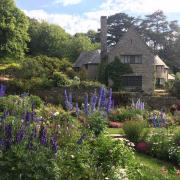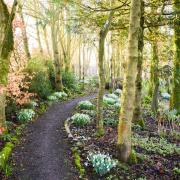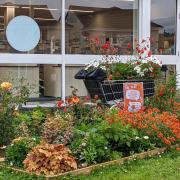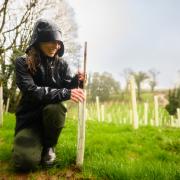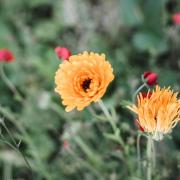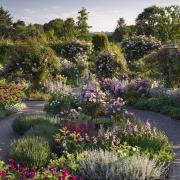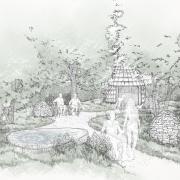Cheer yourself up on a dull day with a visit to Rosemoor's latest addition, the Hot Garden. Words and pictures by Jan Barwick
I first visited Rosemoor's new Hot Garden on a murky day at the beginning of July. Roger Webster, designer of this new addition to Rosemoor's extraordinary horticultural palette, walked me down through the luscious pastel extravaganza that was the shrub rose garden. In front, framed by formal hedges, was a low, stone-built wall. We reached the terrace behind it and suddenly, pow!
"What I wanted," said Roger, "was to keep things hidden, to be walking through this tranquil, soft-coloured environment provided by the roses and then suddenly feeling, zonk, that someone had switched on the light. It's a classic Edwardian gardener's trick to achieve maximum impact."
He has certainly achieved his aim. The wide, granite-paved terrace, constructed by Brian Lakeland of Lakeland Landscaping (07970 182690), runs across virtually the whole top of the square, and in the hour or so that we were there, a succession of visitors walked to the edge of the wall and stopped, open-mouthed at what was before them.
It's a sea of colour: brilliant yellows, hot oranges, pillar-box reds, deep smouldering purples. It stops you in your tracks.
The Hot Garden concept here is not new - there has been a focus for years on zinging colour in what was previously known as the Square Garden, but, as Christopher Bailes, who has been curator since Rosemoor's inception in 1988, says: "When the garden was built, the resources were much more limited and there was also a much more restricted range of plants available. A lot of the woody specimens in particular were getting too big, so the feel in the Square Garden had changed. At Rosemoor we're continually looking for new ways to present plants and gardening to our visitors, so we felt it was an ideal time to start again, to renovate the garden from scratch."
And this is where Roger Webster, whose submission was chosen above several other South West designers, came in. Roger's winning design was a simple one with the focus very much on the plants. He replaced the original central seating area with the broad terrace at the top which bears four formal planters containing gold-leaved Norway maple, Acer platanoides 'Princeton Gold'. These provide shade for the seating beneath.
A wide perimeter path follows the shape of the square with two smaller curved paths crossing the middle. "I wanted the visitor to enjoy the impact that you get from the terrace, seeing the whole garden in one go, but then to be able to get close to the plants below them and to easily read the labels." Roger's design has also turned the considerable slope of the garden (around 1.5m fall from top to bottom) into a positive benefit: subjects close to the terrace are knee- to waist-high while those at the bottom are much taller. "You look out over the space and have the impression that it's level, but by the end of summer the plants down the bottom are above your head, and as you walk down you feel as if you're sinking in amongst them."
Rosemoor's soil is a silty clay, so before any replanting took place, the ground was deeply cultivated and plenty of attention paid to the drainage. For the paths granite setts edge a resin-bonded gravel: it looks like proper gravel but heavy rains don't wash off loose stones into the drains, which had been an earlier problem. With a few exceptions - a large and unusual berberis, two fastigiate copper beeches at the bottom entrance, a purple Norway maple and a golden elm - all the plants were taken out, so Roger started with a virtual blank canvas.
His brief required new ideas and contemporary planting, but at the same time retaining tested stalwarts that were known to thrive at Rosemoor, like the kniphofias, Solidago 'Goldenmosa' and Pleioblastus. Some were included that Roger would probably not have considered.
"These 'Bees' Flame' lobelias were spectacular last July, but in most normal gardens they're martyrs to slugs," he said. "But they do really well here because the garden is so well tended. What I did introduce in the central area is more naturalistic planting with plenty of grasses and herbaceous plants chosen to really sock you in the eye, but relatively few shrubs."
Panicum grasses were incorporated into the scheme for purple-edged foliage that intensifies in colour in September, and varieties of Miscanthus that go red, orange or a deep straw colour later on. "This means that there's still good colour right into October and November." Purple foliage also comes from bronze fennel, canna lilies, dahlias like the spectacularly colourful 'Bishop of Llandaff' and the cut-leaved elder Sambucus nigra 'Eva', "which you can cut right back so they stay herbaceous". This just wasn't available when Rosemoor first opened. Other subjects have purple stems (Eupatorium) or like Ligularia 'The Rocket', purple-edged leaves.
New additions to the garden which hadn't been tried before include the yarrows (Achillea 'Paprika' is a particularly attractive red variety,) the ginger lily Hedychium densiflorum 'Assam Orange', which produces impressive orange spikes in late summer, and my particular favourite, the shaggy-capped blooms of bergamot Monarda 'Squaw'. All are doing well, although the Hedychium is a bit of a late starter this year after our freezing February.
Although colour starts in the Hot Garden in April, and it nearly knocked me out in early July, the garden will be at its flowering peak in August and September, with plenty to see right through into late autumn. If you want to find inspiration for developing a hot border in your own garden (and all the plants are well labelled so you know exactly what you're looking at), you won't find better.
RHS Rosemoor is on the A3124 a mile south of Great Torrington. The garden is open daily 10am-6pm.
Roger Webster can be contacted on 01392 877717, http://www.webstergardens.co.uk





